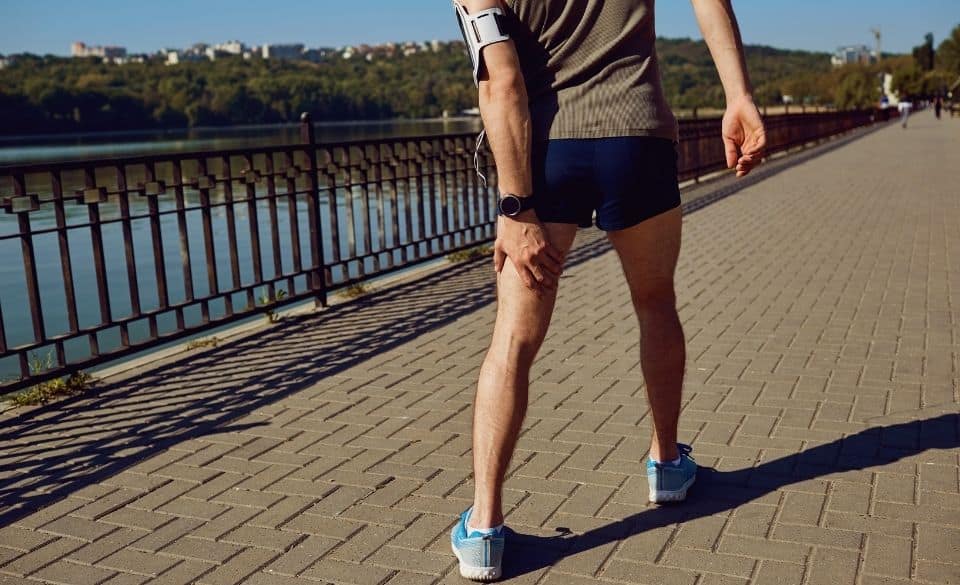
Hamstring Niggle Meaning, Recovery & More – UPDATED 2021
Page Contents
As a runner, the phrase niggle, is generally used to describe injuries, pain, or soreness that disrupt training. Often these niggles can turn into serious injuries, putting the runner out of action for weeks or even months.
The hamstring is one of these places where the niggle meaning is most common. So let’s look at what a hamstring niggle is and how you can recover from it.
Hamstring Niggle Meaning
If your new to the running scene, the phrase “niggle” probably isn’t something you have heard before. A hamstring niggle or just a general niggle should be treated like an injury.
Any discomfort, whether muscular or structural, could be a sign that a serious injury is developing. Knowing this, you must take precautions to prevent these niggles from becoming worse.
For distance runners, most hamstring niggles are caused by microtears that cause stiffness and discomfort during and after running. However, if left untreated, it can turn into a much more severe injury.
Some of the injuries that runners develop in the hamstrings are muscle strains. These are often felt higher up in the hamstring muscles, closer to the sit bones.
The hamstring is made up of three muscles, the semitendinosus, semimembranosus, and biceps femoris. So, if any of these muscles become fatigued or overused, it can start to hinder your running performance.
Most injuries in the hamstring are caused by overload. That means either your hamstring was stretched too far or suddenly overloaded through an increase in training, a fast movement, or a repetitive action.
While hamstring injuries are more common within sprinters, it still affects many distance runners because of the repetitive motion.

Hamstring Niggle Recovery
The first step in hamstring niggle recovery is to understand how serious the injury is.
– Does it hurt?
– Does it prevent you from running?
– Does it hurt when you extend your leg?
– Is there any swelling or bruising?
For less serious niggles, ice and rest is the main form of treatment. Often any discomfort you feel will pass within a few days. But it is important during that time to allow the hamstring to recover. Usually any light niggles will still allow the runner to train, but it is still recommended to take a few days of recovery.
If you are dealing with a strain, it is important to rest from running and apply ice to the affected muscle for up to 20 minutes at a time. Doing so will help relieve any pain you may feel. Cold therapy helps reduce inflammation and reduce any swelling you may have also.
Other recovery methods can include foam rolling and compression. Foam rolling helps to relieve any tension in the muscles, while compression can aid in blood flow and support the muscle when active.
If the strain prevents you from running sometimes other cardio activities can replace the running until you are fully recovered. This includes cycling and swimming, which are both low-impact exercises.
Recovery can be anywhere from 4 to 8 weeks for partial tears and strains. However, for more serious tears, it can take up to 3 months for a full recovery.
Can I Run With A Grade 1 Hamstring Strain?
If what you thought was a hamstring niggle turns into a grade 1 hamstring strain, stop running immediately. With a grade 1 tear, it is important that you rest from running until the injury is fully healed.
During the recovery, it is important not to stretch the hamstring for three weeks or so. The scar tissue needs time to develop over the tear and any form of stretching will disrupt this process.
Continue to ICE and rest, if the pain worsens or if there are any visible signs of swelling, see a physio. Once you have recovered from the strain a physio will provide a rehab program to help you ease back into running again. This will both help redevelop strength and range of movement in the hamstring.
However, with a grade 1 strain, around 33% of people suffer another tear in the first weeks running again. So, it is important you follow advice from your running coach and physio before starting running again or increasing intensity or mileage.

Grade 1 Hamstring Strain Recovery Time
Just like any injury, recovery time depends on the severity of the injury, recovery, and the individual. For most grade 1 hamstring strains, the recovery time is around 3 weeks. This means sporting activity should be stopped for about three weeks. For grade 2 tears you will need a minimum of four to eight weeks.
If the general timeline isn’t followed or inadequate rehabilitation is done you will increase the risk of re-injury. Hamstring strains have a high percentage of re-injury, especially in the first month. So, make sure you follow the physio’s advice and take your time getting back to running.
Once the strain has healed you will need to go through a rehab period of 2-8 weeks before increasing mileage or introducing more intense workouts again.
For most people, it will take around 8-10 weeks to resume normal training again. However, remember to slowly build up the volume again and continue to stretch and ice during this period.
If you are unsure about how to start training again talk to your physio or a running coach. Both these people can help provide advice to help you get back to your previous fitness.
Alternately if you are constantly being affected by niggles, SportCoaching can help develop a training plan that can help you get more consistency from your training while staying injury free. Sign up with your email below, and one of our coaches will be in contact with you for a free consultation.



